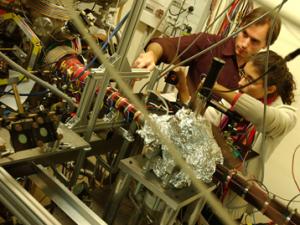Fermions tend to avoid each other and cannot "travel" in close proximity. Demonstrated by a team at the Institut d'optique (CNRS/Université Paris 11, Orsay-Palaiseau), this result is described in detail in the January 25, 2007 issue of Nature. It marks a major advance in our understanding of phenomena at a quantum scale.
For many years, the theory of quantum mechanics stipulated that certain particles, the fermions(1), were incapable of "travelling" in close proximity. For example, in a jet of identical particles, the theory supposed that the distance between them was always greater than a given value, called the "correlation length".

Scientists in the Charles Fabry Laboratory at the Institut d'optique, working with a team from the Free University in Amsterdam, have recently shown that this "anti-bunching" property, which it had never been possible to demonstrate hitherto, does indeed exist. It is as if the particles repel each other, even though interactions between them are negligible. In fact, this "anti-bunching" is due to quantum interferences which forbid the probability of finding two very close particles.
To arrive at this conclusion, the scientists compared the behaviour of fermions with that of bosons(2), under identical conditions. Amongst the latter, the same interferences led on the contrary to a "bunching" effect, and thus an increased probability of finding two particles together.
The experiments at the Institut d'optique were performed using the same system (which ensured identical conditions) on two helium isotopes. In this situation, the scientists demonstrated the correlation length of fermions, which was close to a millimetre. This effect was anticipated, but its demonstration constitutes an advance in our ability to detect correlations between atoms, and thus a further step towards understanding the behaviour of matter at the quantum scale.
Notes :
1) A family of particles which counts electrons, protons, neutrinos, helium3 and quarks amongst its members.
2) A family of particles to which photons, helium4 and gluons belong.
References :
Comparison of the Hanbury Brown–Twiss effect for bosons and fermions, T. Jeltes, J. M. McNamara, W. Hogervorst, W. Vassen, V. Krachmalnicoff, M. Schellekens, A. Perrin, H. Chang, D. Boiron, A. Aspect & C. I. Westbrook. Nature, 25 janvier 2007, Vol. 445, No. 7126
Note: This story has been adapted from a news release issued by CNRS.





Comments